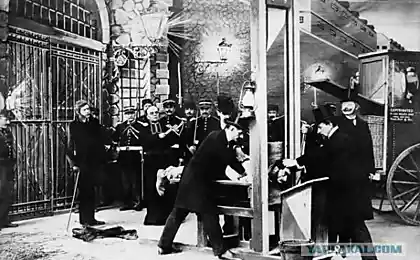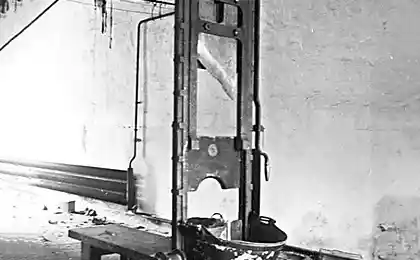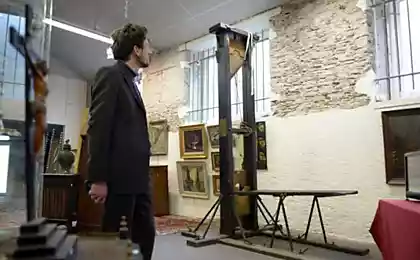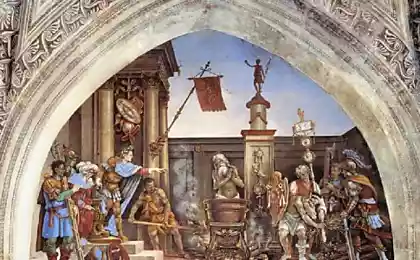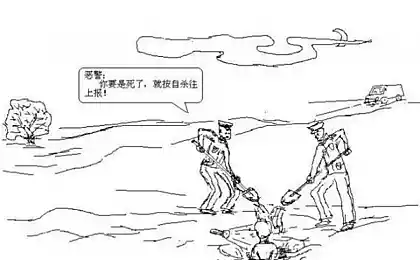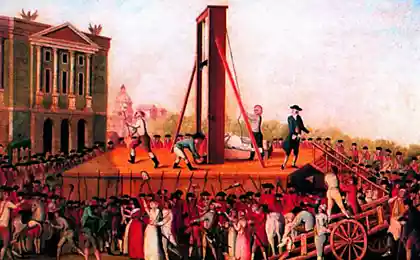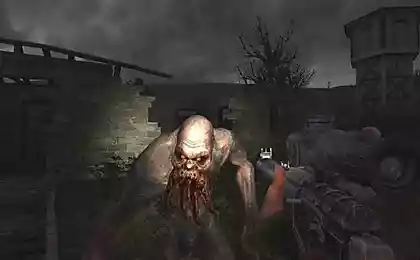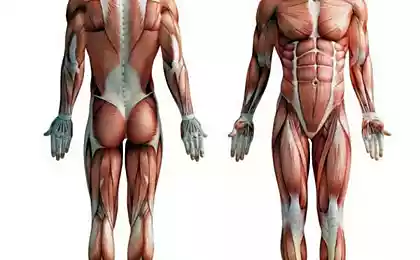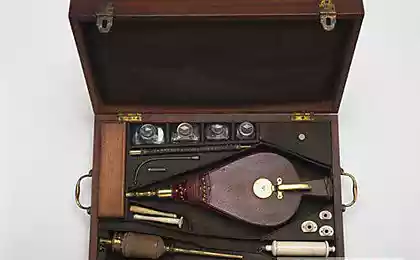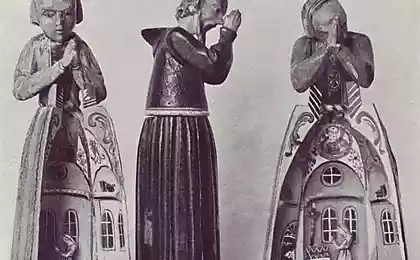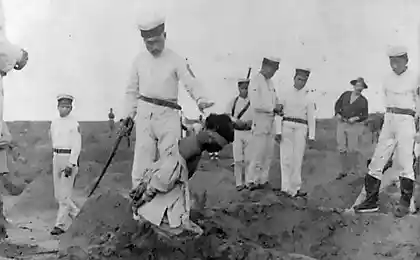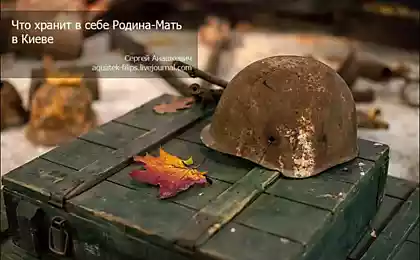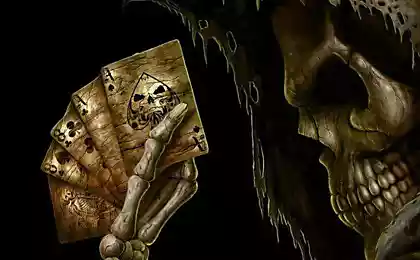1991
Guillotine.
15 ph.
Guillotine - a mechanism for the enforcement of the death penalty by cutting off the head.

2. Guillotine consists of a heavy (40 - 100 kg) oblique knife (a slang name - "lamb"), a freely moving along vertical wooden rails. The knife was raised to a height of 2-3 meters and held the rope.
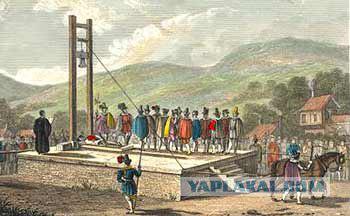
3. Head gilotiniruemogo placed in an indentation at the base of the mechanism, and then the rope, holding a knife, let go, and he fell at high speed on the neck of the victim.

4. decapitation using a guillotine was widespread mechanized form of execution, invented shortly before the French Revolution. The aim of the invention was to create a painless and quick method of execution. (on a photo guillotine cigar)))

5. Once the head was cut off, the executioner raised her and showed the crowd. Some believed that the severed head could see for about ten seconds. Thus, a man's head lifted so that he could see before he died laughing at him the crowd.
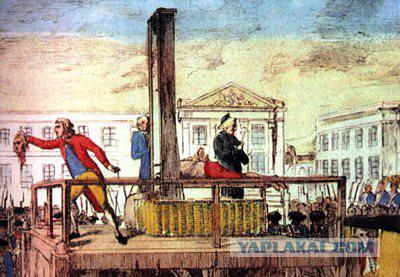
6. In 1792 was introduced the guillotine. April 25, 1792 at the Place de Greve guillotine was first used as a weapon of execution: he was executed common thief Nicolas Pelletier.
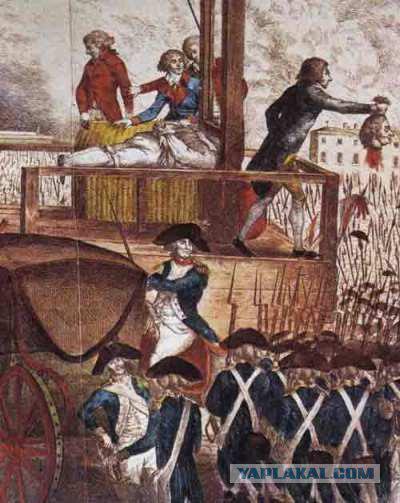
7. The crowd of onlookers, accustomed since the Middle Ages to the "refined" executions, was disappointed speed guillotined.

8. Shortly guillotine moved to the Place de Greve on the Republic Square (now the Place de la Concorde, where the majority of executions took place Revolution), and already January 21, 1793 it was executed Louis XVI. The guillotine was not canceled due to the subsequent formation of its extraordinary amenities.
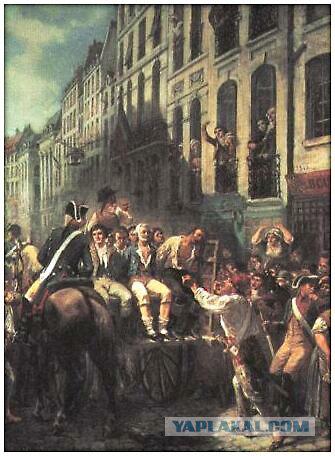
9. The penalty is carried out for a long time only in public: in a sentence of convicts said that he will cut his head at a public place in the name of the French people. Observe and medieval rituals: in the last morning of the convict declared: "Be of good cheer (the surname)! The hour of redemption has come, "and then asked if he did not want a cigarette, a glass of rum.
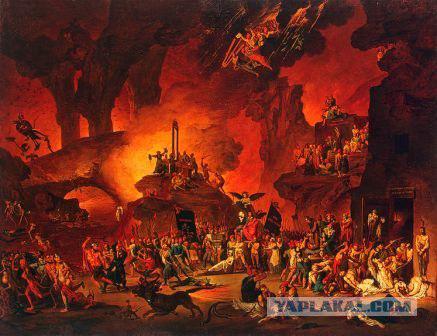
10. After the First World War executed on the boulevards, where there is always a large crowd gathered. In 1932, before the Sante prison, Paul was executed gargoyles, a Russian emigre, the author of works that are signed Brad Paul, for the murder of the President of the Republic Paul Doumer.

11. Seven years later, June 17, 1939, at 4 hours 50 minutes in Versailles on the boulevard beheaded Evgeny Veydmanu, the assassin of seven people.

12. This was the last public execution in France because of the obscene crowd unrest and scandal to the press was told to continue to hold the execution in prison.
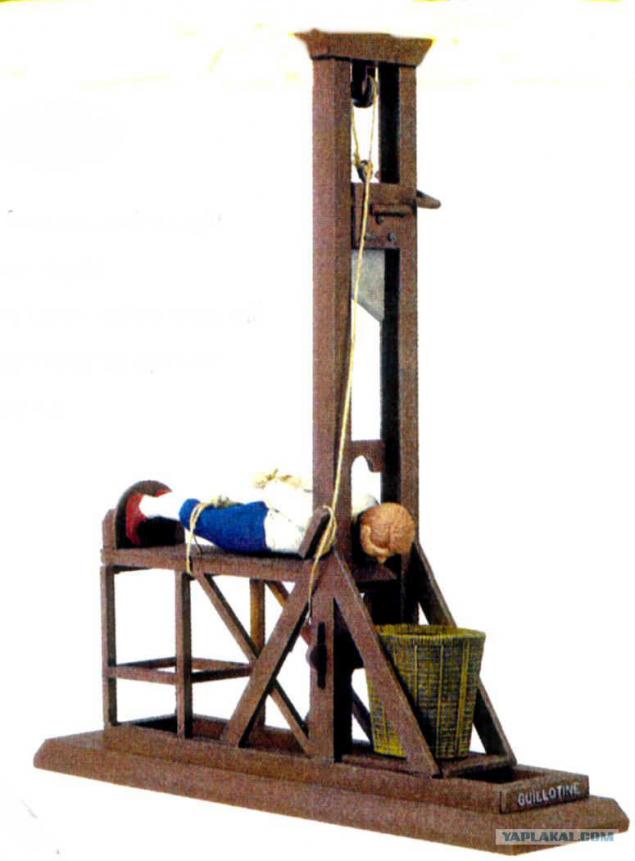
13. The last execution by beheading by guillotine was performed in Marseille, during the reign of Giscard d'Estaing, September 10, 1977. Executed Arab origin called Hamida Djandoubi. It was the last death penalty in Western Europe.
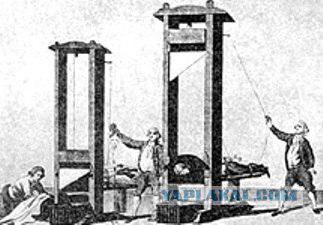
14. Deal, Teutonic guillotine early Middle Ages, remained fragmentary information, but there is no doubt that it really existed. Sometimes called Deal "hobel" or "dolabra" and there is evidence that one such machine for beheading was set in the old days in the old Nuremberg Palace. In addition to these data at our disposal are only artistic reproduction Deal that give a contradictory picture of this machine, and suggest that there are two kinds of it. One of the prints stored in the archive Feldhauz in Wilhelmshaven, depicts a semi-automatic machine, which is to bring into force the executioner was required to strike a heavy mallet on the knife.
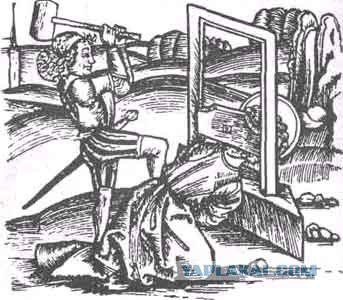
15. Rannegermanskaya semiautomatic guillotine.
It shows us a more familiar type of guillotine, actuated by means of a rope and pulley, heavy knife which falls from a great height on the neck of the convicted person. This figure raises some doubts about the veracity of the scenes depicted on it as an essential attribute of a symbolic Matthew, who became one of the 12 Apostles to replace Judas, has always been dvulezvenny ax otsekshy his head. Here we see the beheading of St. Matthew by a mechanical device.
The existence Deal questioned Alister Kershaw (in his "History of the guillotine"): "It is serious doubt the assertion that the Germans also contributed to the creation of mechanical devices for decapitation, because no reliable information on the Deal, so what we are given, for example, about "Halifax car" Camden and Holinzhed not exist ".
Part of information here:
www.torturesru.org/tortures/methods/dile.shtml
giliotiny.narod.ru/
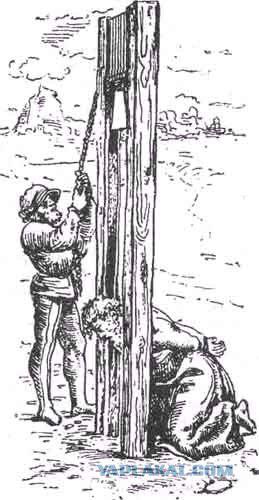
Source:
Guillotine - a mechanism for the enforcement of the death penalty by cutting off the head.

2. Guillotine consists of a heavy (40 - 100 kg) oblique knife (a slang name - "lamb"), a freely moving along vertical wooden rails. The knife was raised to a height of 2-3 meters and held the rope.

3. Head gilotiniruemogo placed in an indentation at the base of the mechanism, and then the rope, holding a knife, let go, and he fell at high speed on the neck of the victim.

4. decapitation using a guillotine was widespread mechanized form of execution, invented shortly before the French Revolution. The aim of the invention was to create a painless and quick method of execution. (on a photo guillotine cigar)))

5. Once the head was cut off, the executioner raised her and showed the crowd. Some believed that the severed head could see for about ten seconds. Thus, a man's head lifted so that he could see before he died laughing at him the crowd.

6. In 1792 was introduced the guillotine. April 25, 1792 at the Place de Greve guillotine was first used as a weapon of execution: he was executed common thief Nicolas Pelletier.

7. The crowd of onlookers, accustomed since the Middle Ages to the "refined" executions, was disappointed speed guillotined.

8. Shortly guillotine moved to the Place de Greve on the Republic Square (now the Place de la Concorde, where the majority of executions took place Revolution), and already January 21, 1793 it was executed Louis XVI. The guillotine was not canceled due to the subsequent formation of its extraordinary amenities.

9. The penalty is carried out for a long time only in public: in a sentence of convicts said that he will cut his head at a public place in the name of the French people. Observe and medieval rituals: in the last morning of the convict declared: "Be of good cheer (the surname)! The hour of redemption has come, "and then asked if he did not want a cigarette, a glass of rum.

10. After the First World War executed on the boulevards, where there is always a large crowd gathered. In 1932, before the Sante prison, Paul was executed gargoyles, a Russian emigre, the author of works that are signed Brad Paul, for the murder of the President of the Republic Paul Doumer.

11. Seven years later, June 17, 1939, at 4 hours 50 minutes in Versailles on the boulevard beheaded Evgeny Veydmanu, the assassin of seven people.

12. This was the last public execution in France because of the obscene crowd unrest and scandal to the press was told to continue to hold the execution in prison.

13. The last execution by beheading by guillotine was performed in Marseille, during the reign of Giscard d'Estaing, September 10, 1977. Executed Arab origin called Hamida Djandoubi. It was the last death penalty in Western Europe.

14. Deal, Teutonic guillotine early Middle Ages, remained fragmentary information, but there is no doubt that it really existed. Sometimes called Deal "hobel" or "dolabra" and there is evidence that one such machine for beheading was set in the old days in the old Nuremberg Palace. In addition to these data at our disposal are only artistic reproduction Deal that give a contradictory picture of this machine, and suggest that there are two kinds of it. One of the prints stored in the archive Feldhauz in Wilhelmshaven, depicts a semi-automatic machine, which is to bring into force the executioner was required to strike a heavy mallet on the knife.

15. Rannegermanskaya semiautomatic guillotine.
It shows us a more familiar type of guillotine, actuated by means of a rope and pulley, heavy knife which falls from a great height on the neck of the convicted person. This figure raises some doubts about the veracity of the scenes depicted on it as an essential attribute of a symbolic Matthew, who became one of the 12 Apostles to replace Judas, has always been dvulezvenny ax otsekshy his head. Here we see the beheading of St. Matthew by a mechanical device.
The existence Deal questioned Alister Kershaw (in his "History of the guillotine"): "It is serious doubt the assertion that the Germans also contributed to the creation of mechanical devices for decapitation, because no reliable information on the Deal, so what we are given, for example, about "Halifax car" Camden and Holinzhed not exist ".
Part of information here:
www.torturesru.org/tortures/methods/dile.shtml
giliotiny.narod.ru/

Source:
